“The one thing that hermit crabs never do is kill the occupant of the shell before moving in.”
– Helen Scales, Spirals in Time – The Secret Life and Curious Afterlife of Seashells
By Mohd Amirul Faisal
Cover image credit: COURTESY OF © BBC
Imagine that you are taking a stroll alongside the shorelines of a beautiful and pristine island surrounded by crystal clear waters. As you are about to lay down on layers of golden brown sand, you witness something quite bizarre. Attending parties organized by either our workplace or by families is a part of our life as social human beings. However, seeing a group of crustaceans forming lines and taking each other’s turns to test whether or not they can fit themselves in a single individual shell – Is a valuable experience.
These are the hermit crabs. The only crustaceans that scavenge even piles of empty seashells and make them as their permanent and mobile homes. Nonetheless, the life of these remarkable creatures can provide us valuable moral lessons that everyone on the planet should consider. First and foremost, dwelling within the curious life of a hermit crab should be a priority if we truly want to comprehend it.
Hermit crabs are not true crabs
The consensus is that hermit crabs belong to the same group as crabs. That assumption has already been resolved quite a long time ago when marine biologists began to conduct several phylogenetic studies suggesting that hermit crabs do not possess the most significant traits that make them true crabs. The primary differences are their exoskeletons. If you have soft-shelled blue crabs for dinner, you can easily see that their entire bodies are covered with hard exoskeletons. The same applies to many other species of crabs.
On the contrary, hermit crabs do indeed feature tough exoskeletons at the front of their bodies. However, if you try to remove their hard-earned shells, a soft tail can be seen protected by the discarded shells from other marine critters. They are more related to lobsters than crabs which is ironic since lobsters do not have to search for a mobile home to protect themselves.
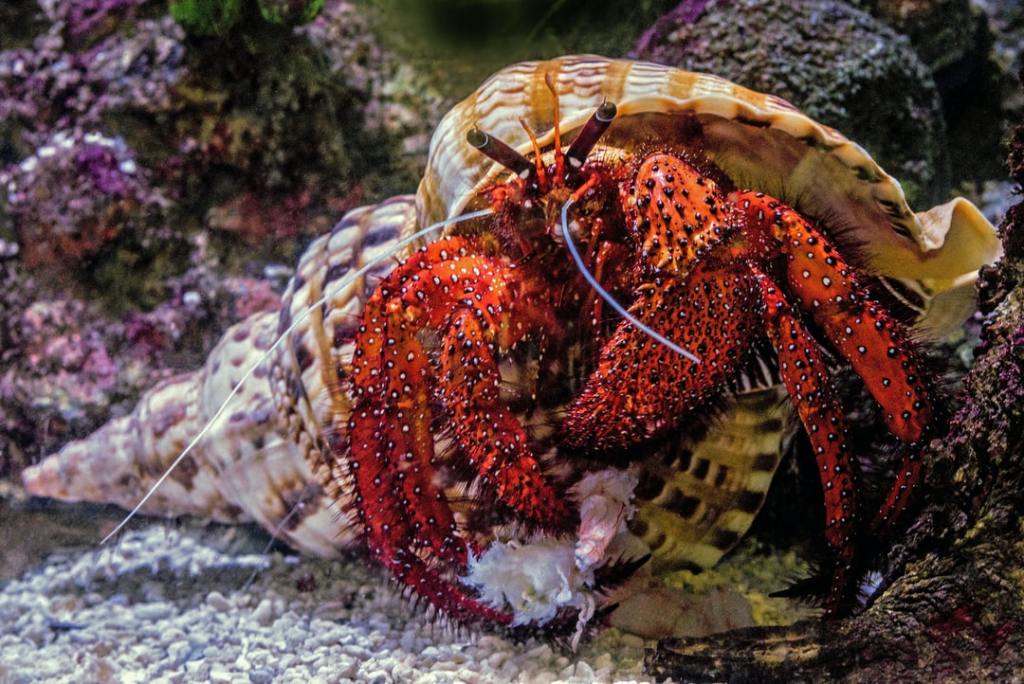
A hermit crab utilizing what seems to be a discarded triton shell as its mobile home. 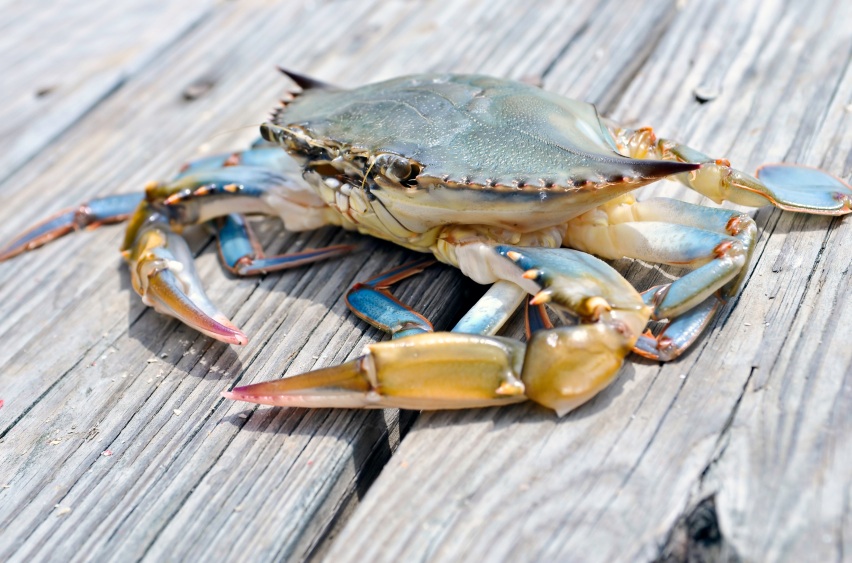
A blue soft shelled crab.
There are about 800 species of hermit crabs scattered across a myriad of habitats. Most of them inhabit marine environments from tidal flats and around coral reefs to the ocean depths. A few species have been documented to survive in freshwater environments. People usually are more familiar with the land-dwelling hermit crabs as keen pet lovers tend to keep them in their homes. Even though their population is vulnerable by aquarium and pet shop trades leading to unsustainable practice. Contrary to their marine counterparts, they have already adapted to life on land and do not require gills to breathe.
This situation brings us to the question of a part of its curious lifestyle. When and How exactly did hermit crabs obtain their first shells?
Searching for a suitable home can be daunting..
Life as a newborn hermit crab can be challenging. Unfortunately, that is what thousands of tiny swimming larvae have to experience right after they hatch from eggs carried by the female upon entering the ocean. These microscopic creatures with the given name zoeae, usually require around 60 days before evolving into another stage called megalopa. Assuming if they can survive the threats of the marine ecosystem around them. At this stage is where hermit crabs will begin to search for their first shell. Since they are still minuscule, shells discarded from dead sea snails are a perfect match for them.
It is a harsh world out there. Thus, a constant cycle of shell-changing needs to be maintained until they achieve adulthood. At the same time, a megalopa’s obligation to survive for at least another 30 days is intensely vulnerable as they also need to avoid many increasingly sized predators that have a refined taste for baby hermit crabs. Afterward, they will emerge as a brand new molted juvenile individual.
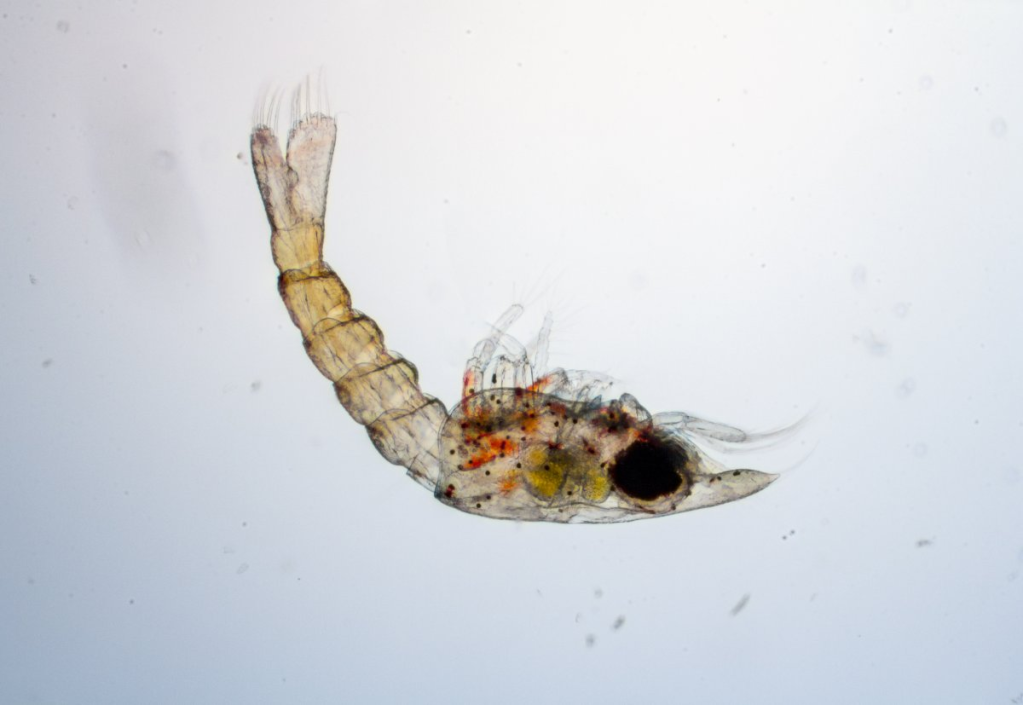
Zoeae larva of a hermit crab. (From Aurthur_Dent). 
Stages of a larva hermit crab before entering megalopa stage. [Source: (Brodie & Harvey,2001).
Even after reaching adulthood, hermit crabs still need to ensure that their delicate bodies are always protected with any suitable shell that they can find. This means using their finely tuned sense of smell to detect whereabouts of gastrapods or molluscs that are being eaten by larger predators. How did they do it? Through the scent of peptide molecules that are produced when enzymes from predator-spit digests the meat of cockles, clams or any other similar mollusc.
If you can’t steal a shell, fight for it.
Watching two hermit crabs engaging a fight with each other is like watching a knight trying to inflict as much damage as possible towards the defender who wears more durable suits of armor wielding a larger sword.
Hermit crabs cannot risk themselves if they expose their naked bodies to the surrounding environments swarmed with predators in every nook and cranny. Empty shells that fit for every hermit crab are uncommon in the wild. Hence, things will get crabby as two opponents encounter each other to settle the score. However, a crab-crab encounter occasionally begins with a ritualized show of claws. It means fully-sized claws indicate the strength and fighting ability of an individual. Hopefully, things can settle down without a fight. If it does not work, then an inevitable hermit crab battle will go down anyway.
Surprisingly, the weaker hermit crab with smaller claws will repeatedly thrust its claws towards its opponent. Perhaps as a sign of intimation to make its opponent surrender. Watching them fighting each other can be satisfying. You can notice one of them will try to hammer as much force towards its opponent’s shell. Either the attacker will run out of stamina to overwhelm its opponent’s defensive armor or the defender itself abandons its home and escape from the fight.
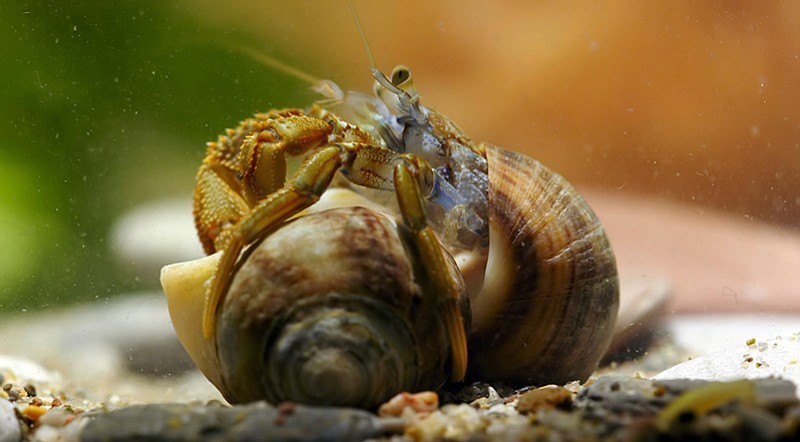
Not all shells have to be fought through means of violence however. The land hermit crabs took a rather different approach. Instead of fighting each other until one of them relinquish their movable homes, a party of hermit crabs starts as they get together and forming lines.
One man’s trash is another crab’s treasure
Land hermit crabs are known to take whatever they can scavenge on shorelines. Beaches that are covered with a lot of garbage either thrown away by irresponsible humans or ones that are washed away by the tides serve a great spot for these crustaceans. It can be either a piece of wood pierced with holes or discarded plastic bottles. Sometimes, people have captured images of hermit crabs occupying a toothpaste opener. Unless if other hermit crabs are also present searching for the same thing. When there are numerous hermit crabs around, most shells already have their owner.
It comes down to the last resort. Fortunately, it does not involve wrestling each other again. Socializing is proven to provide many advantages in the animal kingdom. Animals that live in groups such as lions and elephants will always look out for each other. Hermit crabs, utilize their communication skills to ensure that choosing shells is conducted in a civilized manner. At least in the natural world.
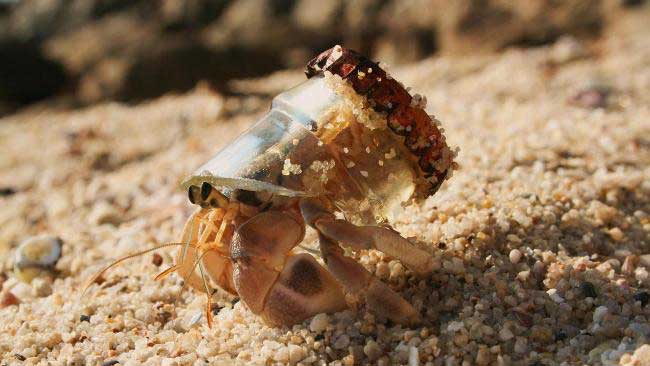

The hermits usually gathered in a large group surrounding an individual shell. Larger ones will tag along at one end, leading to the smallest at the other. Hence, a size-ordered line is formed consisting of various sizes of hermit crabs. Behavior ecologists who studied their lifestyle called it a vacancy chain, similar to how humans do it with houses and jobs. If things become more hectic and many hermit crabs are around, an orderly formed line will result in a tug of war.
Sizable hermit crabs will try to wrestle over the empty shell while the smaller ones needlessly shift queues searching for the fastest lines. It is like when you are at the supermarket walking through all the lanes to find the quickest counter lines. Eventually, only a single line will obtain control of it and claim victory.
The losers with their old shells escape from the scene. Each of the champions will receive a new home shell. It is followed by abandoning their old shells and move out into their new homes of the crab one place ahead of the queue. Surprisingly, this method provides a lot of benefits to hermit crabs. Just a single abandoned shell can give new homes to a dozen of them. You can also watch how shell trading commencement occurs in the video below.
Plastic pollution is threatening hermit crabs
We have already seen how hermit crabs took every opportunity that lies in their pathways to collect any abandoned shell that they can find. Through the vacancy chain, it has been proven that many hermit crabs obtain their new homes just from a single shell alone. Even though hermit crabs have the advantage to scavenge whatever objects that they can find, nasty consequences can still occur.
Plastic containers are the primary culprits here. As previously mentioned, hermit crabs used their acute sense of smell to detect nearby predation from carnivorous snails consuming bivalves such as clams. Unfortunately, hermit crabs will tend to crawl into plastic containers and glass bottles after it uncovers an abandoned shell left by its previous owner. The problem arises when the exits are constructed in such a way that makes them difficult to escape. Eventually, these bottles will contain dead hermit crabs, unable to find a way out.
The very same evolutionary mechanism that allows hermit crabs to find new shells can also lead to their demise from liters of plastic containers. It is the exact reason why we need to reduce as much plastic waste as possible. Hermit crabs play a crucial in the ecosystem as they help to fertilize the soil. They also ensure that shorelines are in a clean state.
Human intervention will only make the lives of these hermits more difficult than usual. Without their presence, most beach ecosystems will collapse.
References:-
- Carter, L. Where Do Hermit Crabs Get Their Shells? — Hermit Crab Answers. Hermit Crab Answers. Retrieved from https://www.hermitcrabanswers.com/where-do-hermit-crabs-get-theirshells/#:~:text=Hermit%20crabs%20are%20not%20true%20crabs%2C%20in%20that,predator.%20All%20hermit%20crabs%20start%20life%20as%20zoeae.
- Renae Brodie, Alan W. Harvey, Larval Development of the Land Hermit Crab Coenobita Compressus H. Milne Edwards Reared in the Laboratory, Journal of Crustacean Biology, Volume 21, Issue 3, 1 July 2001, Pages 715–732, https://doi.org/10.1163/20021975-99990169
- Scales, H. (2015). Spirals in time (1st ed., pp. 137-141). Bloomsbury Sigma.
- Vlamis, K. (2019). Plastic pollution has killed half a million hermit crabs, study says. BBC News. Retrieved from https://www.bbc.com/news/science-environment-50661449.
